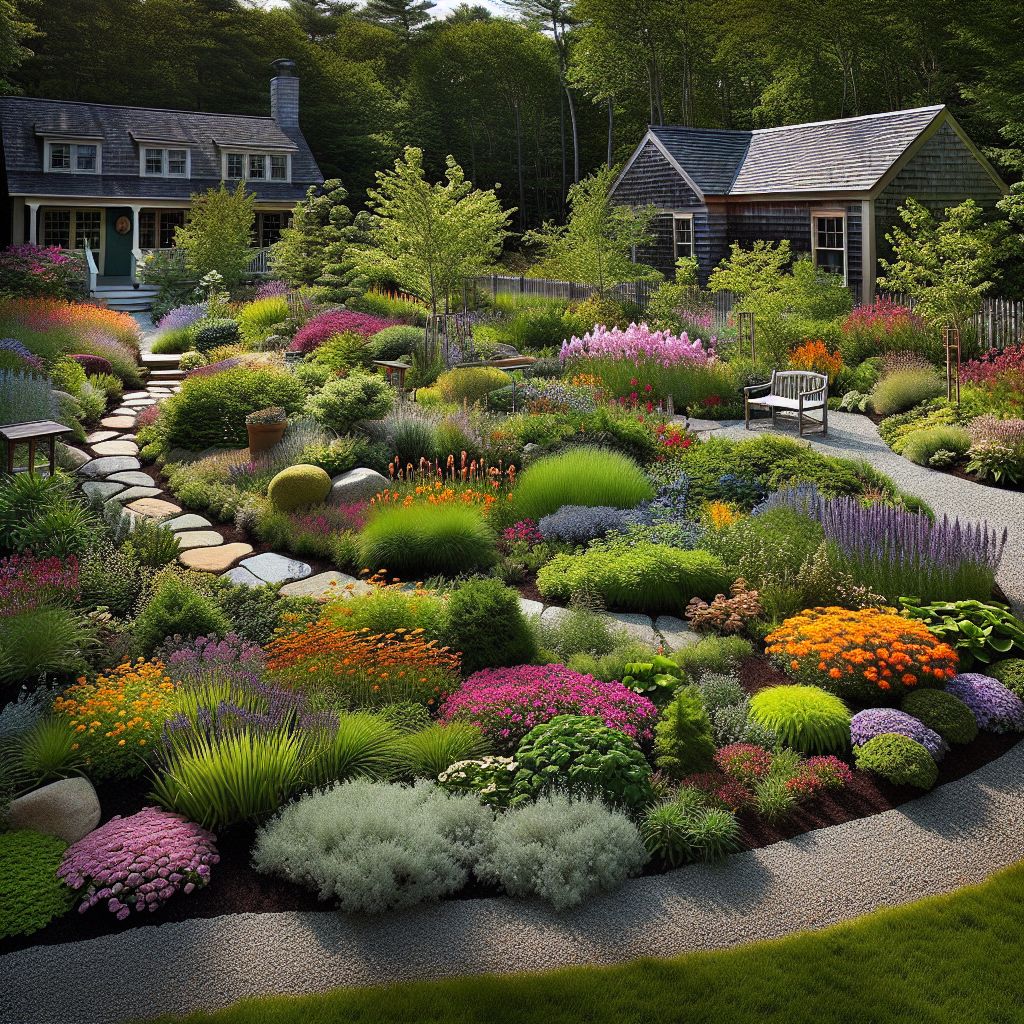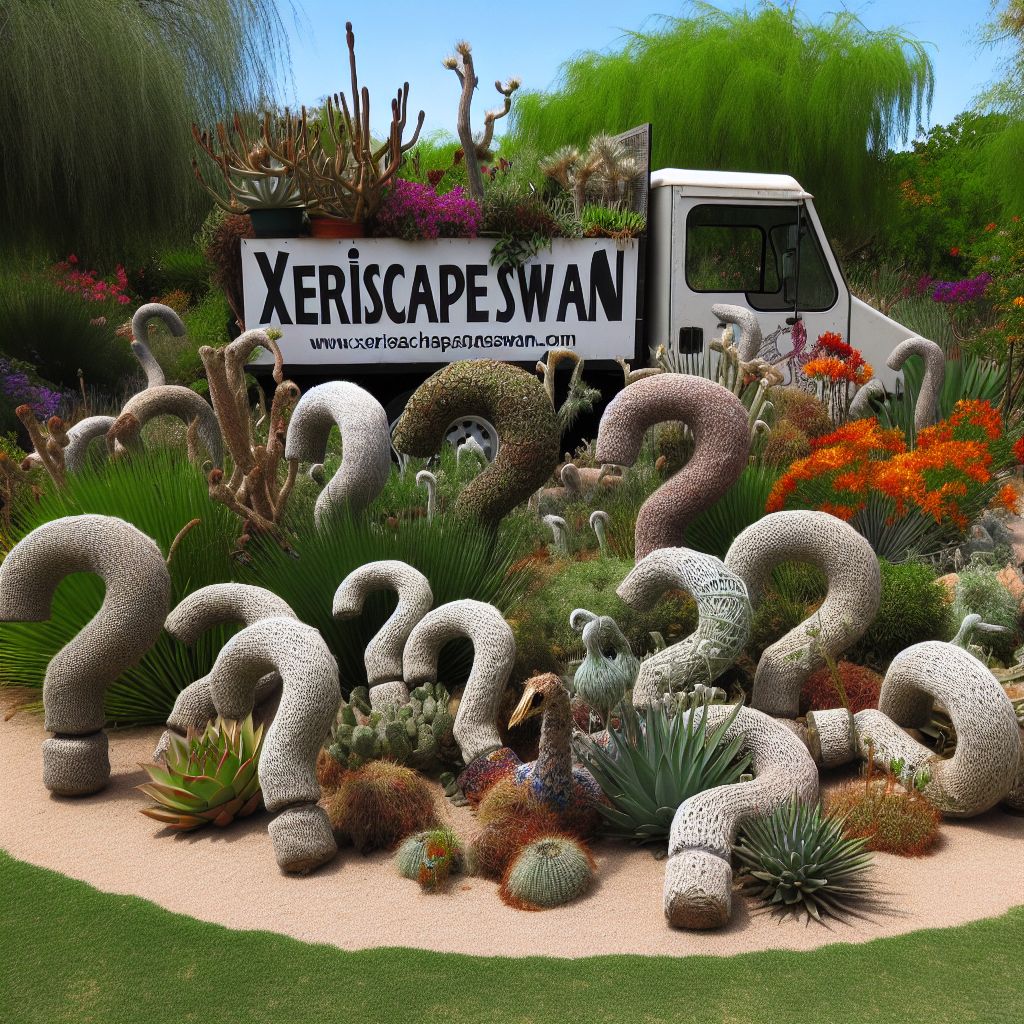
Key Takeaways
- Native xeriscape plants require less water, saving resources and time.
- Oklahoma’s climate and soil are ideal for various native xeriscape plants.
- Planning is crucial: Consider sun exposure, soil type, and plant water needs.
- Xeriscaping benefits include reduced maintenance and a haven for wildlife.
- Start small and expand your xeriscape garden as you gain confidence and experience.
Growing Green: Oklahoma’s Guide to Low-Maintenance Native Xeriscapes
Let’s dive into the world of
The Heart of Xeriscape: Embracing the Native Landscape
Xeriscape, a term coined from the Greek word “xeros,” meaning dry, is not about creating a desert-like landscape. Instead, it’s about making smart choices that align with the natural environment. By selecting plants native to Oklahoma, you’re choosing species that are naturally equipped to handle the local weather and soil conditions.
Why Native Plants are a Game-Changer for Oklahoma Gardeners
Native plants have spent thousands of years adapting to Oklahoma’s unique climate, making them incredibly resilient. They’re accustomed to our summer heat, the occasional cold snap, and the unpredictable rainfall. This adaptation means less watering, fewer chemicals, and more time enjoying your garden rather than laboring over it.
Furthermore, native plants provide essential food and shelter for local wildlife, promoting biodiversity. When you plant natives, you’re not just gardening but restoring a piece of the ecosystem.
Creating Your Own Oklahoma Xeriscape: A Step-by-Step Guide
Starting your own xeriscape is easier than you might think. Begin by observing your garden space. Note where the sun beats down the hardest, where shade lingers, and how the terrain slopes. This information is your roadmap to selecting the right plants for the right places.
Unearth the Secrets of a Successful Oklahoma Xeriscape
Xeriscape: What It Is and Why It’s Beneficial
- Reduces water usage: Oklahoma faces periods of drought, making water conservation a priority.
- Low maintenance: Less mowing, weeding, and pruning means more time to relax.
- Supports local wildlife: Native plants attract pollinators and birds, enriching your garden’s ecosystem.
Xeriscaping is about working with the land, not against it. By choosing plants that are meant to be here, you’ll create a garden that’s both resilient and beautiful.
Spotlight on Oklahoma’s Native Palette: Plants That Thrive Naturally
Oklahoma’s native plants offer an array of options for the xeriscape gardener. From the sun-loving coneflowers to the shade-tolerant ferns, there’s a native plant for every garden corner. The key is to choose plants that match your garden’s conditions.
- Sun Lovers: Black-eyed Susans and Indian Blankets are perfect for those full-sun spots.
- Shade Dwellers: Look to Coral Bells and Oakleaf Hydrangea for those cooler, shaded areas.
- Drought Tolerant: Yucca and Prairie Dropseed grass can handle the heat without a sweat.
By selecting the right plants, you can ensure that your xeriscape garden will be successful from the start.
Plotting Your Xeriscape Path
Decoding Your Garden’s Language: Reading Sun, Soil, and Slope
Every garden speaks its own language through its unique conditions. Start by mapping out the sun’s path across your garden. Note which areas receive full sun, partial shade, or full shade. Test your soil to understand its type and pH level, as this will influence which plants will thrive. Observe the slope of your land to anticipate how water will move through your garden. Armed with this knowledge, you’ll be ready to choose plants that will flourish in your specific conditions.
Designing with Adaptation in Mind: The Aesthetics of Resilience
Design is a critical component of xeriscaping. It’s not just about how plants look; it’s about how they work together. When designing your xeriscape, think about the movement of the sun, the flow of water, and the interaction of plants. Create spaces where hardy grasses can sway in the breeze alongside flowering perennials, and where each plant complements the other not only in appearance but also in function.
Grouping Thirsty Companions: Water Zoning for Efficiency
Water zoning is all about grouping plants with similar water needs together. This strategy is crucial for efficient water use. In your xeriscape, you’ll have zones for plants that can survive on rainfall alone, zones for those that need a bit of supplemental watering, and zones for the occasional thirsty plant. This way, you’re not wasting water on plants that don’t need it and giving extra care to those that do.
Nature’s Palette: Choosing the Right Plants
Now comes the fun part: picking the plants. When you’re selecting plants for your xeriscape, it’s essential to consider their water needs, their sunlight requirements, and how they’ll interact with the existing plants in your garden. Opt for a mix of perennials, grasses, shrubs, and trees to create a diverse, year-round landscape that’s beautiful and beneficial for the environment.
Don’t forget to consider the height, color, and blooming season of your plants. You’ll want to create a garden that has visual interest throughout the year. Layer your plants so that each season brings a new spectacle, with early bloomers giving way to summer flowers, followed by autumn colors and interesting winter textures.
The Grasslands Heritage: Tough, Tantalizing Tufts
Grasses are the backbone of a xeriscape garden, especially in Oklahoma, where our heritage is tied to the prairie. Grasses like Little Bluestem and Switchgrass are not only drought-tolerant but also add movement and texture to your garden. They’re the perfect complement to the more vibrant blooms of wildflowers.
Floral Emblems of the Prairie: Blooms That Laugh at Drought
Oklahoma’s wildflowers are legendary, and for good reason. Coneflowers, black-eyed Susans, and Gaillardia, or blanket flowers, are all drought-resistant and heat-loving. These plants bring a splash of color to your xeriscape and provide nectar for pollinators like bees and butterflies.
Casting Shadows: Woody Shrubs and Trees of the Wild
Shrubs and trees offer shade and structure and serve as windbreaks and privacy screens. Choose species like the Oklahoma Redbud or the Eastern Red Cedar, which are adapted to our climate and provide habitat for birds. These woody plants are a long-term investment in your garden’s future.
Oklahoma Xeriscaping: Native Plants
| Plant Name | Key Features |
|---|---|
| Caddo Sugar Maple (Acer saccharum ‘Caddo’) | – Variety of sugar maple with dark green leaves – Drought-tolerant and heat-resistant – Provides vibrant fall color |
| Eastern Red Cedar (Juniperus virginiana) | – Evergreen tree native to Oklahoma – Highly drought-tolerant – Provides year-round interest and screening |
| Smooth Sumac (Rhus glabra) | – Native shrub with red fall foliage – Tolerates poor, dry soils – Attracts wildlife and pollinators |
| Purple Coneflower (Echinacea purpurea) | – Drought-tolerant perennial with purple daisy-like flowers – Blooms summer to fall – Attracts butterflies and other pollinators |
| Switchgrass (Panicum virgatum) | – Versatile native grass that tolerates drought and erosion – Provides vertical interest and movement in the garden – Attractive seed heads in fall |
References:
https://oklahomaproven.okstate.edu/
https://extension.okstate.edu/fact-sheets/xeriscaping-drought-resistant-landscaping.html

Cultivating Your Garden: The Nitty-Gritty of Planting and Care
Once you’ve selected your plants, it’s time to get your hands dirty. Proper planting is key to a successful xeriscape. Dig holes twice as wide as the root ball but no deeper. This gives roots room to spread without suffocating. Add a layer of mulch to conserve moisture and keep weeds at bay.
Breaking Ground: Preparation and Planting Techniques
Before planting, prepare your soil. If it’s heavy clay, work in some compost to improve drainage. If it’s sandy, add organic matter to help retain moisture. Plant in the cooler parts of the day to reduce stress on the plants and on yourself. Water deeply after planting to encourage roots to grow down, seeking moisture and stability.
The Virtues of Water Wisdom: Irrigation Practices
Even in a xeriscape, some watering is necessary, especially during establishment. The goal is deep, infrequent watering that encourages strong root growth. Drip irrigation or soaker hoses are ideal because they deliver water directly to the base of the plant, minimizing evaporation and waste.
Mulch Magic: Protection and Preservation of Soil Moisture
Mulch is your garden’s best friend. It keeps the soil cool, retains moisture, and suppresses weeds. Organic mulches like wood chips or shredded bark also add nutrients to the soil as they break down. Apply a 2-3 inch layer around your plants, keeping it away from their stems to prevent rot.
Remember, xeriscaping is a journey. Your garden will grow and change over time. Be patient and adjust as necessary. With each season, you’ll learn more about your plants’ needs and your garden’s personality.
Admiring the Fruits of Your Labor: Established Xeriscape Gardens
After your xeriscape is established, it’s time to step back and admire the fruits of your labor. An established xeriscape is a living tapestry of color, texture, and life. It’s a garden that works with the rhythms of nature, requiring less from you and giving more back to the environment.
Residential Retreats: Inspiring Transformations of Oklahoma Homes
Across Oklahoma, homeowners are transforming their traditional landscapes into xeriscapes. These gardens are not only more sustainable, but they also add curb appeal and value to homes. Imagine your own front yard reborn as a lush, low-maintenance oasis, setting an example for the whole neighbourhood.
As your xeriscape matures, it will become a haven for birds, butterflies, and beneficial insects. Your garden will become a place of beauty and a sanctuary for the wildlife that shares our space.
Visualization: Before and After Xeriscape Showcase
Witnessing the transformation from a high-maintenance lawn to a low-maintenance xeriscape is nothing short of magical. Through careful planning and planting, Oklahoma gardeners are creating outdoor spaces that are both environmentally friendly and aesthetically pleasing. The before and after pictures tell a compelling story of change, one that can inspire others to embark on their own xeriscaping journey.
Continuous Bloom: Keeping Your Garden Vibrant Through the Seasons
A well-planned xeriscape doesn’t just conserve water; it also provides year-round interest. By selecting various native plants that bloom at different times, you can create a garden that’s always alive with color and activity. In spring, enjoy the bright yellows of Goldenrod; summer brings the bold reds of Indian Paintbrush; fall is highlighted by the purples of Asters; and even in winter, the evergreen foliage of Eastern Red Cedar provides a splash of green against the stark landscape.

Frequently Asked Questions (FAQ)
How Do Native Plants Benefit Local Wildlife?
Native plants are more than just beautiful; they’re a crucial part of the local ecosystem. They provide habitat and food sources for various wildlife, from pollinators like bees and butterflies to birds and small mammals. By creating a xeriscape with native plants, you’re not only saving water; you’re also creating a sanctuary for the creatures that call Oklahoma home.
These plants have evolved alongside local wildlife and are perfectly adapted to meet their needs. For example, the nectar-rich flowers of Milkweed are the sole food source for Monarch butterfly caterpillars, while the dense foliage of native grasses offers shelter for ground-nesting birds.
By incorporating native plants into your garden, you’re providing essential resources for wildlife, promoting biodiversity, and contributing to the health of our environment.
What Are the Best Practices for Watering a Xeriscape Garden?
Watering a xeriscape garden is about efficiency and deep watering. The best practice is to water infrequently but thoroughly, encouraging plants to develop deep root systems. This makes them more drought-resistant and less dependent on supplemental watering. Using a drip irrigation system or a soaker hose can help deliver water directly to the plant’s roots, where it’s needed most, without wasting it through evaporation or runoff.
It’s also important to water at the right time of day—early morning or late afternoon is best to reduce water loss. And remember, native plants will often thrive on rainfall alone once they’re established, so be mindful not to overwater.
Can Xeriscaping Be Done in Any Type of Soil?
Yes, xeriscaping can be done in virtually any soil type, but it may require some preparation. If your soil is heavy clay, you must amend it with organic matter to improve drainage. If it’s sandy and drains too quickly, adding organic matter can help retain moisture. The key is understanding your soil and working with it to create the best environment for your xeriscape plants.
How Do You Control Pests in a Low-Maintenance Xeriscape?
Pest control in a xeriscape garden relies on prevention and natural methods. Healthy, native plants are less susceptible to pests, to begin with, but you can also encourage beneficial insects that prey on common garden pests. Planting various species creates a balanced ecosystem where predator and prey keep each other in check.
If pests do become a problem, opt for targeted, organic solutions rather than broad-spectrum pesticides, which can harm beneficial insects and the overall health of your garden.
For example, if you’re dealing with aphids on your milkweed plants, introducing ladybugs can be an effective and natural way to reduce the infestation.
How Can I Add Color to My Xeriscape Throughout the Year?
Adding color to your xeriscape year-round is all about plant selection. Choose a mix of perennials, shrubs, and grasses with different colors and textures in each season. Here’s a seasonal guide to help you plan:
- Spring: Wildflowers like Indian Blanket and Prairie Phlox start the year with a burst of color.
- Summer: Heat-tolerant plants like Purple Coneflower and Black-eyed Susan thrive in the intense sun.
- Fall: Autumn Sage and Goldenrod bring warm tones to the garden as the temperatures cool.
- Winter: Evergreens like Eastern Red Cedar and ornamental grasses provide greenery and structure.
By layering these plants in your garden, you’ll ensure a tapestry of color that changes with the seasons, keeping your xeriscape vibrant all year long.
As you can see, creating a xeriscape garden with Oklahoma native plants is not only possible but also a rewarding way to garden sustainably. It’s an investment in the beauty and health of your outdoor space and the wider environment. So, roll up your sleeves, and let’s start planting for a greener Oklahoma!




Leave a Reply